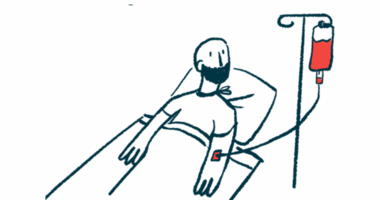Hemophilia A
Hemophilia A is a rare genetic disorder that affects the blood’s ability to clot properly. It is the most common form of hemophilia, responsible for 80% of all cases.
The condition is caused by a genetic mutation that leads to a deficiency or dysfunction of a protein called factor VIII (FVIII), which is crucial in the blood clotting process.
When someone has hemophilia A, also known as classical hemophilia, their blood takes longer to clot after an injury, which can result in prolonged bleeding, both externally and internally.
The disorder is often passed down from parent to child. But in about one-third of cases, it may result from a spontaneous mutation in the gene.
More than 400,000 males worldwide have hemophilia A. In the U.S., the disease affects about 1 in every 5,000 male births; about 400 babies are born with it each year. People of all races and ethnicities are affected by hemophilia A at roughly equal rates.
Hemophilia A is different from hemophilia B, which is caused by mutations in the F9 gene. Both cause abnormal bleeding.
Hemophilia A genetics and inheritance
Hemophilia A inheritance follows an X-linked recessive pattern. This is because the faulty F8 gene responsible for the disease is located on the X chromosome, one of the two sex-determining chromosomes in humans.
Males have one X chromosome inherited from their mother, and one Y chromosome from their father. If a male inherits an X chromosome with a faulty F8 gene, he will have hemophilia A.
Females have two X chromosomes, one inherited from each parent. If a female inherits one X chromosome with a faulty F8 gene and one with a healthy F8 gene, she is considered a carrier.
Carriers may not have symptoms of hemophilia A, but can pass the affected F8 gene to their children.
There may be variations and nuances in specific cases. Advances in genetic research may lead to a more detailed understanding of hemophilia A.
Symptoms of hemophilia A
In general, hemophilia symptoms vary in severity, with some people having mild bleeding while others may have more severe and frequent episodes.
The main symptom of hemophilia A is bleeding that happens extremely easily and lasts an unusually long time.
For newborns and infants, hemophilia A symptoms may include:
- spontaneous intracranial bleeding, sudden bleeding within the brain or surrounding membranes that occurs without any apparent trauma or injury to the head
- prolonged bleeding from the stump of the umbilical cord, a possible early sign of hemophilia A
- excessive bleeding after circumcision
- bleeding after vaccinations or injections
- unexplained bruising.
For adolescents and adults, symptoms may include:
- prolonged bleeding, with even minor injuries or cuts causing bleeding that may be difficult to stop
- being easily bruised, with bruises possibly being larger and more severe than normal
- point pain and swelling as a result of repeated bleeding into the joints (also known as hemarthrosis), such as the knees, elbows, and ankles, which can erode joint cartilage if not properly managed
- excessive bleeding during surgery or dental procedures
- internal bleeding, affecting areas such as the mouth and muscles, which is an indicator of severe hemophilia A.
Hemophilia A is often diagnosed in the first few months of life. In about two-thirds of cases, the diagnosis is confirmed shortly after birth.
Those with milder forms of hemophilia A usually don’t have spontaneous bleeding. They may have excessive bleeding after an injury or surgery, however.
Some people with milder hemophilia A may not be diagnosed until adulthood.
Hemophilia A treatment
While there is no cure for hemophilia A, treatments are available to help manage symptoms, improve life expectancy, and reduce the risk of complications.
Hemophilia A treatment is tailored to the severity of a person’s condition, their bleeding symptoms, and lifestyle.
Factor replacement therapy
The cornerstone of hemophilia A treatment involves administering a working form of the absent clotting protein. This treatment temporarily corrects the clotting defect, allowing the blood to clot properly and stop bleeding. This type of therapy can be used to prevent bleeding or to stop bleeding once it occurs (on-demand treatment).
Clot-promoting medications
Other medications such as Hemlibra or antifibrinolytics that encourage blood clotting can be used, particularly for mild to moderate cases. Some people with mild hemophilia A can benefit from DDAVP (desmopressin), a medication that stimulates the release of stored factor VIII from within the body.
Bypassing agents
For people with inhibitors, antibodies against factor VIII, bypassing agents may help manage bleeding.
Gene therapy
Gene therapy can deliver a healthy version of the defective gene and restore the body’s ability to produce its own functional clotting proteins.
Hemophilia A diagnosis
Hemophilia A is diagnosed through medical evaluations and tests. This may be done by a hematologist, a doctor who specializes in blood disorders.
A physical examination will include questions about a person’s medical history, including whether there is a family history of bleeding disorders.
To determine the severity and frequency of bleeding episodes, the doctor will ask about symptoms, such as spontaneous bleeding, unusual bruising, and bleeding that occurs after injuries or surgeries.
The doctor may order a screening blood test, which is a general assessment of blood health and clotting ability. A definitive diagnosis of hemophilia A is made through a clotting factor test to confirm low levels of clotting factor VIII.
Living with hemophilia A
Living with hemophilia A is manageable with the right medical care and lifestyle choices.
These may include:
- learning about hemophilia A, its treatment and potential complications, as this aids informed decision making
- receiving regular medical care from a hematologist or at a specialized hemophilia treatment center to monitor the disease and prevent complications (In the U.S., there are more than 140 hemophilia treatment centers, often located at major university medical and research centers, while the Canadian Hemophilia Society is associated with 26 bleeding disorder treatment centers throughout Canada)
- receiving factor replacement therapy on a regular basis to prevent bleeding episodes, or as needed
- minimizing risks, such as using protective gear during physical activities and avoiding contact sports that could lead to injury
- managing pain during bleeding episodes and from joint damage, which can include medications and physical therapy
- staying physically active, eating a balanced diet, and maintaining a healthy weight to help keep joints and muscles strong
- boosting mental health by talking with family and friends, joining a support group, and getting mental health therapy to address the emotional challenges of living with a chronic condition like hemophilia A
- having a plan in case of a bleeding emergency, along with knowing how to administer treatment.
Hemophilia News Today is strictly a news and information website about the disease. It does not provide medical advice, diagnosis, or treatment. This content is not intended to be a substitute for professional medical advice, diagnosis, or treatment. Always seek the advice of your physician or other qualified health provider with any questions you may have regarding a medical condition. Never disregard professional medical advice or delay in seeking it because of something you have read on this website.
Recent Posts
- Battling self-doubt as a woman with bleeding disorders
- Extended hemophilia half-life products aid care, but raise costs
- I’m encouraged to see my son take initiative in solving a problem
- Why asking for and accepting help is important for parents
- What I’ve learned about obesity, joint pain, and hemophilia bleeds
Related articles

 Fact-checked by
Fact-checked by 




